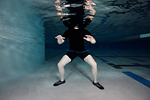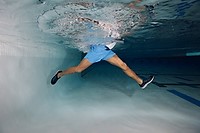
Water fitness classes are offered all over the world. There is a multitude of different kinds of classes that instructors can choose from, and many of these are in shallow water. These include water walking, shallow-water aerobics, high intensity interval training, aqua step aerobics, aqua kickboxing, Aquapole Fitness (which includes a boxing bag), AQUA Drums Vibes, underwater treadmill, underwater bicycle, circuit classes, strength training, Senior Fitness (the Seniors I know get unhappy if you don’t work them hard enough), Aqua Barre, Aqua Pilates, Aqua Yoga, Arthritis Foundation programs, and Ai Chi. What are the benefits of putting all these formats in the pool?
Just getting in the pool lowers blood pressure for most people. The hydrostatic pressure of the water pushes blood out to the extremities, increasing stroke volume and cardiac output, while at the same time lowering the heart rate. Immersion offloads the joints, making movement more comfortable. When joints are submerged in water, they have a greater range of motion. Water also offers resistance, requiring the exerciser to apply more force to their movements. The resistance is in all directions, which promotes muscle balance. Since the water is a dynamic resistant force, the more force that is applied, the more resistance the water offers. Pool temperatures are typically 12-18 degrees cooler than body temperature, and water conducts heat away from the body, so exercisers remain cool and comfortable during exertion. Buoyancy creates a feeling of weightlessness, which is perceived as fun by most exercisers. All of these benefits apply no matter what exercise format you are using.
There is a misconception that exercise in water does not burn as many calories as exercise on land. Of course, the number of calories burned depends on many things including how hard the exerciser works, but given the same amount of effort, an exerciser will burn a comparable number of calories in water as on land, and sometimes even more. Dennis Dolny, Ph.D. reports his research on burning calories through water exercise in the Water Immersion Works guidebook, which can be downloaded on the PlayCore website. The Mayo Clinic also lists an estimated number of calories burned for various activities, and water aerobics compares favorably to other forms of exercise.
Water exercise is usually discounted as an acceptable form of exercise for people with osteoporosis because buoyancy reduces the impact compared to land based exercise. But research on water exercise and osteoporosis is ongoing and has found that shallow water exercise can slow the rate of bone loss and improve bone mineral density. Recommended exercises include jumping/rebounding, strength training and using power or force against the water’s resistance. In addition, the research has noted outcomes of improved strength, flexibility, balance and adherence. The best exercise is the one you can stick with! For more information, see Lori Sherlock’s article in AEA’s first quarter 2024 issue of Leader Tools.
Shallow water is the perfect place to work on balance. People who have fallen are often afraid of falling again and they limit balancing activities on land to minimize the risk of falling, further decreasing functionality. But in the pool, the hydrostatic pressure and buoyancy of the water is supportive, reducing the fear of falling. At the same time, water constantly moves, destabilizing movement and requiring multiple adjustments to maintain balance. Good exercises for improving balance are weight shifting, gait training, postural strength training, use of various foot positions, and one-legged movements. If there are muscle imbalances, these can also be addressed in the pool. For more information, check out the Water Exercise Coach blog post and video.
Finally, every type of equipment made for water fitness can be used in shallow water. That includes buoyant equipment such as noodles and foam dumbbells; drag equipment such as webbed gloves, Aqualogix bells, paddles and Aqua Ohm; resistance tubing; steps; drum sticks and more. There are options to please everyone. Shallow water exercise is definitely not just for little old ladies in shower caps!

Noodles 
Foam Dumbbells 
Webbed Gloves

Aqualogix Bells 
Paddles 
Aqua Ohn

Resistance tubing 
Aqua Step 
Drum Sticks

See you in the pool!




























